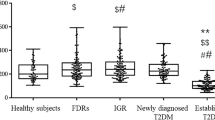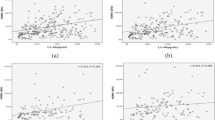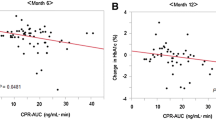Abstract
Aims
This study aimed to explore the level of and changes in the 1,5-anhydroglucitol × glycated hemoglobin A1c/100 (AH index, AHI) associated with different glucose metabolism statuses and to evaluate the islet function and insulin sensitivity of patients with type 2 diabetes (T2DM) with different AHI levels.
Methods
Of the 3562 subjects enrolled in this study, 1697 had T2DM. The disposition index (DI) was the product of islet secretion function and insulin sensitivity-related indexes.
Results
The mean AHI level was 1.0 (0.7–1.3) in the general population, while the mean AHI level in the T2DM group was 0.8 (0.5–1.2), which was significantly lower than that in the impaired glucose regulation and normal glucose tolerance group (both 1.2 (0.9–1.5), both P < 0.01). We further divided patients with T2DM into four subgroups according to the quartile of AHI. The results showed that with the increase in AHI level, the homeostasis model assessment of insulin resistance (HOMA-IR) decreased, while HOMA-β, insulin generation index, insulin sensitivity index, and DI increased (all Pfor trend < 0.01). Multivariate logistic regression showed that the odds ratios for a low DI for increasing levels of AHI were 1.00, 0.22 (0.16–0.29), 0.16 (0.11–0.22), and 0.09 (0.06–0.13), showing a decreasing trend (Pfor trend < 0.05).
Conclusion
The AHI could reflect the variation in glycemic disorder and the function of islet β cells. The lower the AHI, the worse the glycemic disorder, as well as the islet β-cell function.



Similar content being viewed by others
References
RISE Consortium; RISE Consortium Investigators (2019) Effects of treatment of impaired glucose tolerance or recently diagnosed type 2 diabetes with metformin alone or in combination with insulin glargine on β-cell function: comparison of responses in youth and adults. Diabetes 68(8):1670–1680
Bergman RN, Ader M, Huecking K, Van Citters G (2002) Accurate assessment of beta-cell function: the hyperbolic correction. Diabetes Suppl 1:S212–S220
Bergman RN, Phillips LS, Cobelli C (1981) Physiologic evaluation of factors controlling glucose tolerance in man: measurement of insulin sensitivity and beta-cell glucose sensitivity from the response to intravenous glucose. J Clin Invest 68(6):1456–1467
Cersosimo E, Solis-Herrera C, Trautmann ME, Malloy J, Triplitt CL (2014) Assessment of pancreatic β-cell function: review of methods and clinical applications. Curr Diabetes Rev 10(1):2–42
Santos JL, Yévenes I, Cataldo LR et al (2016) Development and assessment of the disposition index based on the oral glucose tolerance test in subjects with different glycaemic status. J Physiol Biochem 72(2):121–131
Takeda Y, Fujita Y, Yanagimachi T et al (2017) Prediabetes exhibits decreased disposition index correlated with deterioration of glycemic parameters in nonobese japanese subjects: a cross-sectional study from medical examination. Metab Syndr Relat Disord 15(6):296–303
Janssen J, van den Berg E, Zinman B et al (2019) HbA(1c), insulin resistance, and β-cell function in relation to cognitive function in type 2 diabetes: the CAROLINA Cognition Substudy. Diabetes Care 42(1):e1–e3
Cai X, Xia L, Pan Y et al (2019) Differential role of insulin resistance and β-cell function in the development of prediabetes and diabetes in middle-aged and elderly Chinese population. Diabetol Metab Syndr 11:24
Ma X, Hao Y, Hu X et al (2015) 1,5-anhydroglucitol is associated with early-phase insulin secretion in chinese patients with newly diagnosed type 2 diabetes mellitus. Diabetes Technol Ther 17(5):320–326
Kanat M, Winnier D, Norton L et al (2011) The relationship between{beta}-cell function and glycated hemoglobin: results from the veterans administration genetic epidemiology study. Diabetes Care 34(4):1006–1010
Campbell L, Pepper T, Shipman K (2019) HbA1c: a review of non-glycaemic variables. J Clin Pathol 72(1):12–19
Harrison LB, Adams-Huet B, Li X, Raskin P, Lingvay I (2014) Intensive therapy in newly diagnosed type 2 diabetes: results of a 6-year randomized trial. J Investig Med 62(4):676–686
Halban PA, Polonsky KS, Bowden DW et al (2014) β-cell failure in type 2 diabetes:postulated mechanisms and prospects for pre-vention and treatment. Diabetes Care 37(6):1751–1758
Weng J, Li Y, Xu W et al (2008) Effect of intensive insulin therapy on beta-cell function and glycaemic control in patients with newly diagnosed type 2 diabetes: a multicentre randomised parallel-group trial. Lancet 371(9626):1753–1760
Selvin E, Rawlings A, Lutsey P et al (2016) Association of 1,5-anhydroglucitol with cardiovascular disease and mortality. Diabetes 65(1):201–208
Su H, Ma X, Yin J et al (2017) Serum 1,5-anhydroglucitol levels slightly increase rather than decrease after a glucose load in subjects with different glucose tolerance status. Acta Diabetol 54(5):463–470
Ying L, He X, Ma X et al (2017) Serum 1,5-anhydroglucitol when used with fasting plasma glucose improves the efficiency of diabetes screening in a Chinese population. Sci Rep 7(1):11968
American Diabetes Association (2010) Standards of medical care in diabetes–2010. Diabetes Care 33(Suppl 1):S11–S61
Matthews DR, Hosker JP, Rudenski AS, Naylor BA, Treacher DF, Turner RC (1985) Homeostasis model assessment: insulin resistance and beta-cell function from fasting plasma glucose and insulin concentrations in man. Diabetologia 28(7):412–419
Matsuda M, DeFronzo RA (1999) Insulin sensitivity indices obtained from oral glucose tolerance testing: comparison with the euglycemic insulin clamp. Diabetes Care 22(9):1462–1470
Cederholm J, Wibell L (1990) Insulin release and peripheral sensitivity at the oral glucose tolerance test. Diabetes Res Clin Pract 10(2):167–175
Nolfe G, Spreghini MR, Sforza RW, Morino G, Manco M (2012) Beyond the morphology of the glucose curve following an oral glucose tolerance test in obese youth. Eur J Endocrinol 166(1):107–114
Ford ES, Giles WH (2003) A comparison of the prevalence of the metabolic syndrome using two proposed definitions. Diabetes Care 26(3):575–581
Merjaneh L, He Q, Long Q, Phillips LS, Stecenko AA (2015) Disposition index identifies defective beta-cell function in cystic fibrosis subjects with normal glucose tolerance. J Cyst Fibros 14(1):135–141
Shah SS, Ramirez CE, Powers AC, Yu C, Shibao CA, Luther JM (2016) Hyperglycemic clamp-derived disposition index is negatively associated with metabolic syndrome severity in obese subjects. Metabolism 65(6):835–842
Hannon TS, Kahn SE, Utzschneider KM et al (2018) Review of methods for measuring β-cell function: design considerations from the Restoring Insulin Secretion (RISE) Consortium. Diabetes Obes Metab 20(1):14–24
Wang W, Liu C, Jimenez-Gonzalez M, Song WJ, Hussain MA (2017) The undoing and redoing of the diabetic β-cell. J Diabetes Complic 31(5):912–917
Saisho Y (2015) β-cell dysfunction: its critical role in prevention and management of type 2 diabetes. World J Diabetes 6(1):109–124
Yazdanpanah S, Rabiee M, Tahriri M et al (2017) Evaluation of glycated albumin (GA) and GA/HbA1c ratio for diagnosis of diabetes and glycemic control: a comprehensive review. Crit Rev Clin Lab Sci 54(4):219–232
Mo Y, Ma X, Li H et al (2016) Relationship between glycated albumin and glycated hemoglobin according to glucose tolerance status: a multicenter study. Diabetes Res Clin Pract 115:17–23
Yamanouchi T, Minoda S, Yabuuchi M et al (1989) Plasma 1,5-anhydro-D-glucitol as new clinical marker of glycemic control in NIDDM patients. Diabetes 38(6):723–729
Acknowledgements
We would like to thank all of the involved clinicians, nurses, and technicians for dedicating their time and skills to the completion of this study. We would like to thank all participants for their dedication to data collection and laboratory measurements.
Funding
This work was funded by the Shanghai Municipal Education Commission—Gaofeng Clinical Medicine Grant Support (20161430) and Shanghai United Developing Technology Project of Municipal Hospitals (SHDC12016108).
Author information
Authors and Affiliations
Contributions
JZ designed the study. HS, LY, and XH collected the data. HS analyzed the data and wrote the draft. XM, YS, WZ, YW, and YB provided technical support. XM and JZ revised the paper and contributed to the discussion. All of the authors read and approved the final manuscript.
Corresponding author
Ethics declarations
Conflict of interest
The authors declare that they have no conflicts of interest.
Ethical approval
This study was approved by the Ethics Committee of Shanghai Jiao Tong University Affiliated Sixth People’s Hospital and was in accordance with the 1964 Declaration of Helsinki and its later amendments or comparable ethical standards.
Informed consent
Informed consent was obtained from all individual participants included in the study.
Additional information
Managed By Antonio Secchi.
Publisher's Note
Springer Nature remains neutral with regard to jurisdictional claims in published maps and institutional affiliations.
Rights and permissions
About this article
Cite this article
Su, H., Ma, X., Shen, Y. et al. 1,5-Anhydroglucitol × glycated hemoglobin A1c/100 as a potential biomarker for islet β-cell function among patients with type 2 diabetes. Acta Diabetol 57, 439–446 (2020). https://doi.org/10.1007/s00592-019-01452-0
Received:
Accepted:
Published:
Issue Date:
DOI: https://doi.org/10.1007/s00592-019-01452-0




